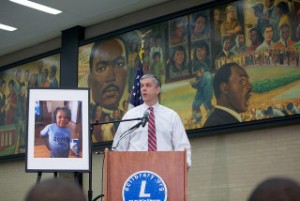
by Zenitha Prince
Special to the NNPA from the Afro-American Newspaper
Officials, lawmakers and civil rights groups commemorated the 50th anniversary of the Elementary and Secondary Education Act of 1965 by calling for much-needed updates to the law.
The measure, many said, was one of the major victories of the Civil Rights Movement and the impetus for opening up educational opportunities for children of color.
“Since 1965, the Elementary and Secondary Education Act (ESEA) has been an essential tool for promoting fair and equal access to quality public education and helping to reduce educational disparities between students of all backgrounds, ethnicities, cultures, abilities, and beliefs,” said Rep. G.K. Butterfield, D-N.C., chairman of the Congressional Black Caucus, in a statement. “The ESEA was critical to upholding and defending the United States Supreme Court’s decision in Brown v. Board of Education which asserted that equity in education is a fundamental right and not a privilege.”
U.S. Secretary of Education Arne Duncan marked the occasion at an event with civil rights leader Wade Henderson, D.C. public school Principal Rachel Skerritt and local students on April 9 at the Martin Luther King Jr. Memorial Library in Washington, D.C.
“ESEA marked an extraordinary step for education, and for civil rights,” Duncan said. “ESEA has built a foundation under our nation’s schools, helping to raise the bar for every child, and to ensure that the resources are there for those most in need. It’s helped create an expectation that no matter where you live in this country, when students aren’t making progress, local leaders will come together to make change—especially if they are students with disabilities, students who are still learning English, students from a particular racial group, students who live in poverty, or students coming from particular school.”
The progress made in the past 50 years has been remarkable, he said, citing higher graduation rates and decreasing dropout rates among Black and Latino students among other achievemnets. But there is also much to be done, he said.
“Why do we have so much work ahead of us?” Duncan asked rhetorically. “Because today, a quarter of high schools with the highest percentage of African-American and Latino students do not offer Algebra II, and a third do not offer chemistry. Because today, about 40 percent of school districts do not offer preschool programs…. Because today, we have far too many students of color, primarily boys, being suspended and expelled from school. And finally, because today, you can search five entire states and find only four girls in those states who took an AP computer science exam.
“Our work will not be done until we ensure that opportunity is not just a possibility, but a promise.”
Part of the solution lies with Congress fixing a broken ESEA, now known as No Child Left Behind, advocates say.
“As we commemorate the 50th anniversary of the ESEA, the Senate is preparing to mark up a bipartisan reauthorization of this historic law. This proposal rolls back federal oversight and accountability for student outcomes, fails to make progress on the equitable distribution of resources, and doesn’t collect important data about the communities we represent,” Henderson, president and CEO of The Leadership Conference on Civil and Human Rights, said. “Congress must reauthorize a strong ESEA that protects children and civil rights. We cannot turn back the clock on the progress we’ve made; any reauthorization that is weaker than current law should not move forward.”




